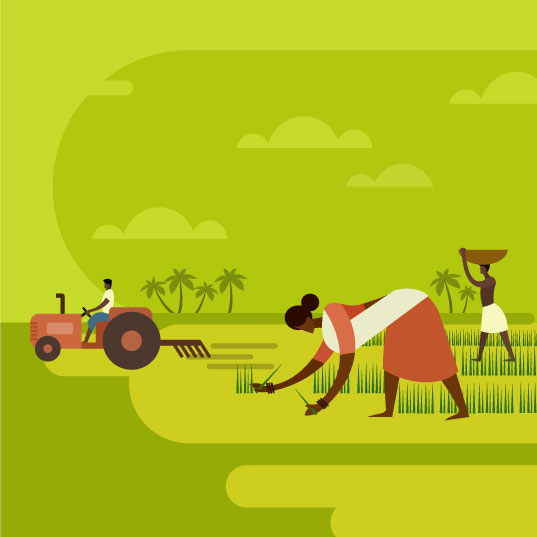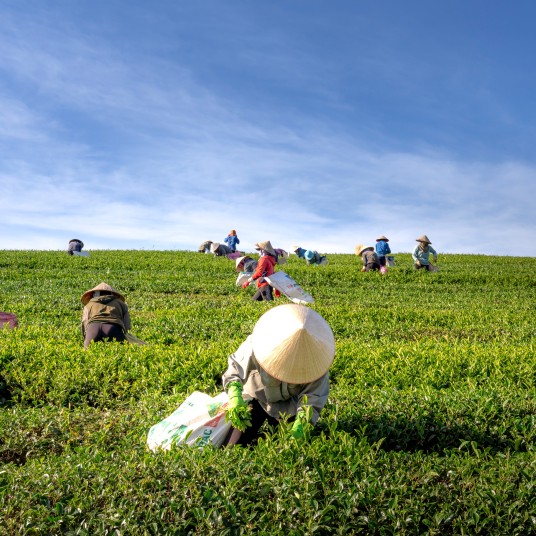Challenges for farmers in the face of worsening climate change
Much farmland is suffering from the effects of climate change: drought, flooding, temperature changes… Climate-smart agriculture has some of the solutions for fighting the problem
The Horn of Africa has spent months tackling its longest and hardest drought in recent history. At the end of 2022, it had gone five consecutive seasons with hardly any rainfall - 40 and 70 percent below average in countries such as Somalia.
Oxfam Intermón reports that one in five children in the country could die from starvation if immediate measures are not taken. The impact of climate change on farming is directly related to the lack of rainfall and food insecurity threatening millions of people in this region of the planet - but it also affects everyone.
What will I learn from this article?
- The relationship between farming and climate change
- Climate challenges for agriculture
- Climate-smart agriculture
The close relationship between farming and climate change
As the temperature of the planet rises, the impacts of global warming are becoming more and more serious. Agriculture is facing a scenario defined by drought, flooding and increasingly frequent and intense extreme weather phenomena. A fact that endangers food security for a constantly growing population (8 billion worldwide at the end of 2022).
“Agriculture is facing a scenario defined by drought, flooding and increasingly frequent and intense extreme weather phenomena”
 Farming is also one of the sectors that produces the most greenhouse gas emissions, between 19 and 29 percent of the total. And, as the World Bank points out, about 80 % of deforestation globally is due to agriculture.
Farming is also one of the sectors that produces the most greenhouse gas emissions, between 19 and 29 percent of the total. And, as the World Bank points out, about 80 % of deforestation globally is due to agriculture.
Growth in food production will also mean an increase in water use of 40-50% in the coming decades. As such, its role in mitigating climate change is crucial. We need crops that can assure food supply while respecting the environment.
We cannot think of the future of farming, climate change and the planet without a transformation of the sector. This implies adopting more efficient and sustainable practices which can, on the one hand, satisfy the needs of a constantly growing global population and, on the other, reduce its impact on the planet.
Climate challenges facing farming
Farming affects climate change at the same time as it suffers its effects. Few sectors are as sensitive to the climate:
- Changes in rainfall: precipitation patterns are changing across the world, bringing with them more intense periods of strong rainfall and longer ones without, including in the same region. Either it doesn’t rain, or it rains much more than crops can bear.
- Changes in temperature: factors such as the rise in average temperatures and increasing periods of extreme heat affect crop and livestock farming. The wine sector has been reporting the changes for years now. With rising temperatures, the ripening of the vine occurs earlier and harvests are brought forward. With increasingly hot summers, and months like August suffering exceedingly high temperatures, maturation parameters can no longer be respected and the plant cycle is harmed.
- Flooding: both flooding and the rising sea level devastate crops, speed up soil erosion, pollute water and damage farming-related infrastructure.
- Drought: for its part, the scarcity of water causes harvests to suffer and restricts their growth. Experts warn that the gradual increase in temperatures will probably result in longer and more intense droughts still.
- Changes in the viability of crops and livestock: farmers select varieties which adapt best to local conditions. As these conditions change over the decades to come, they will be forced to rethink some of their options, which could mean undertaking new capital investments, finding other markets and learning new practices.
- New plagues, pathogens and weed problems: they will also have to tackle new threats. An insect or weed which can no longer thrive in northern Africa could migrate to southern Europe for better conditions in the future and farmers there will have to adapt.
- Increasingly harsh working conditions: as the heat intensifies, farmers will face increasingly harsh and potentially unsafe working conditions.
- Food insecurity: falling agricultural productivity and the sudden loss of crops and livestock will probably have a domino effect, including on food prices, and lead to more food insecurity.
Smart agriculture for tackling the climate crisis
 One of the ways to tackle climate change problems in farming is to seek measures that strengthen resilience and mitigate the consequences for the sector. In this sense, climate- smart agriculture refers to a variety of innovative practices which permit an increase in productivity, improve resilience to climate change and reduce greenhouse effect gases caused by farming activities.
One of the ways to tackle climate change problems in farming is to seek measures that strengthen resilience and mitigate the consequences for the sector. In this sense, climate- smart agriculture refers to a variety of innovative practices which permit an increase in productivity, improve resilience to climate change and reduce greenhouse effect gases caused by farming activities.
African farmers now use, on average, just 20 kg of fertilizer per hectare. To maximize output, local farmers estimate they will need to multiply this tenfold. To do this sustainably, without causing long-term environmental damage, will be crucial. Not only for the African continent, but also for the world. According to the World Economic Forum, the vast and fertile African lands represent the best hope for humanity of food security in the future.
Farming which emphasizes soil health and specific fertilization to achieve sustainably high output is key to reducing carbon footprint. The most efficient application of correct fertilization - only that which is needed and used by the soil and specific farming need - reduces waste and run-off to ground and surface water.
Climate-smart agriculture involves a great variety of measures of this kind. But without doubt the most important concerns the root of the problem: mitigating the effects of climate change and limiting the rise in temperatures. This means urgently and immediately reducing greenhouse gas emissions to zero.
The challenge is to achieve highly efficient and sustainable agriculture, based on science and innovation, with farmers playing the central role in progress.
Sources:
- https://www.sostenibilidad.com/cambio-climatico/que-es-cambio-climatico
- https://www.ucsusa.org/resources/climate-change-and-agriculture
- https://www.weforum.org/platforms/centre-for-nature-and-climate/articles/how-africa-can-help-feed-the-world-davos23
- https://www.bancomundial.org/es/topic/climate-smart-agriculture







